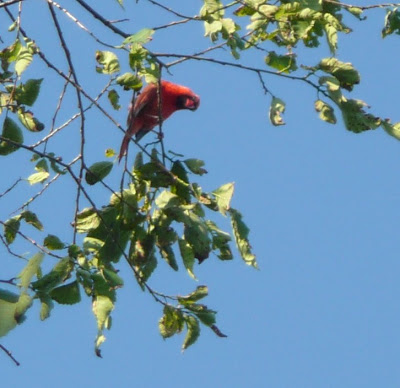How can he be so hard to see?
The Northern Cardinal has a very distinctive call. Some describe it as "peter peter peter" but to me it sounds more like "pew pew pew" - like a LOL-raygun, you know? At any rate, however you describe it, it's a piercing, carrying whistle. What's annoying, then, is hearing that call and not being able to see the bird. I mean, he's bright red. How can he be so hard to see?
But Friday, there he was. Twice: in the morning as I walked in at 7:15, he was clinging to the top branches of a tree, and then in the afternoon as I walked back at 4:45 (a little later than usual), deep in the trees along the creek, preening and occasionally whistling.
Pretty bird. It's nice to see you.
































2 Comments:
-
At 12:35 PM, June 16, 2008
 The Exterminator had this to say...
The Exterminator had this to say...
-
-
At 7:39 PM, June 16, 2008
 The Ridger, FCD had this to say...
The Ridger, FCD had this to say...
-
-
<-- Older Post ^ Home Newer Post -->Ridger:
I'm so glad you're a fellow birder, so maybe I can make life a little easier for you.
Cardinals have a number of different songs. (They also have some calls, but I think you're really talking about songs here.) Unlike in the case of most songbirds, both male and female cardinals sing. So perhaps when you have difficulty spotting the singer, the better camouflaged female is eluding your vision.
The most common songs are "what-cheer what-cheer," "p'chew p'chew," and a kind of kissy sound. But through years of birding, particularly when I'm on a count as the morning chorus begins, I've learned that the best way to identify a cardinal by ear is to listen for the timbre. It's hard to make that kind of distinction in words; I think of the cardinal as being a "full, rich, resonant" whistle, but you might not hear it that way.
"Peter peter peter" is usually associated with titmice, not cardinals. To me, the sound seems somewhat higher than a cardinal's, and not as rich. I've learned to aurally distinguish the cardinal from the titmouse because they're both very common where I live -- and they both get very active around sunrise.
Thanks, Ex. I've come to birding late, and I'm constantly learning things I never knew before.
Post a Comment
Subscribe to Post Comments [Atom]